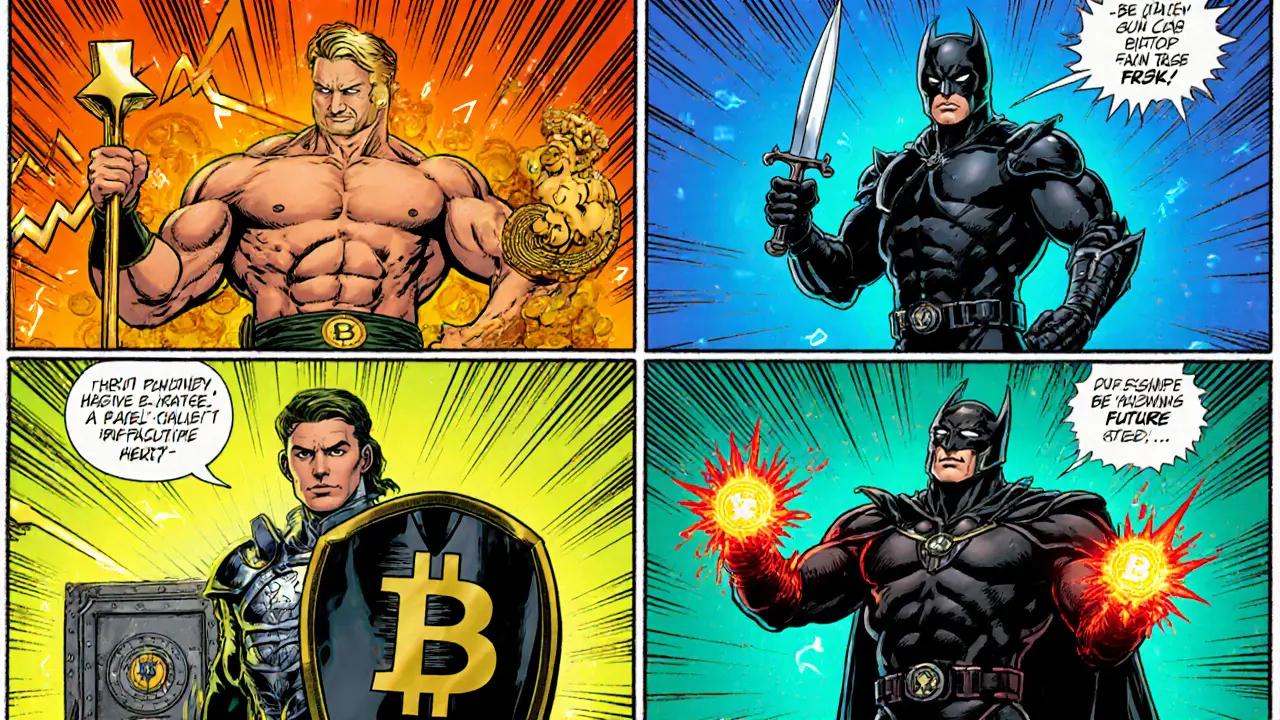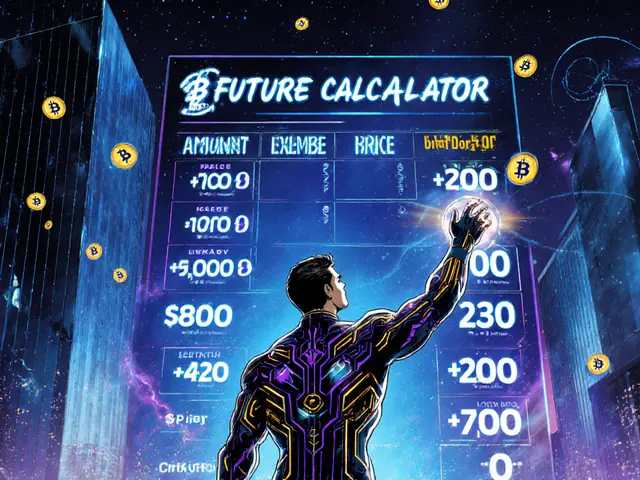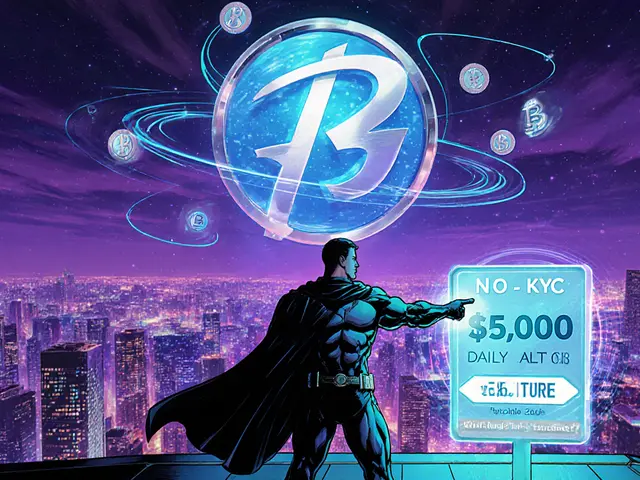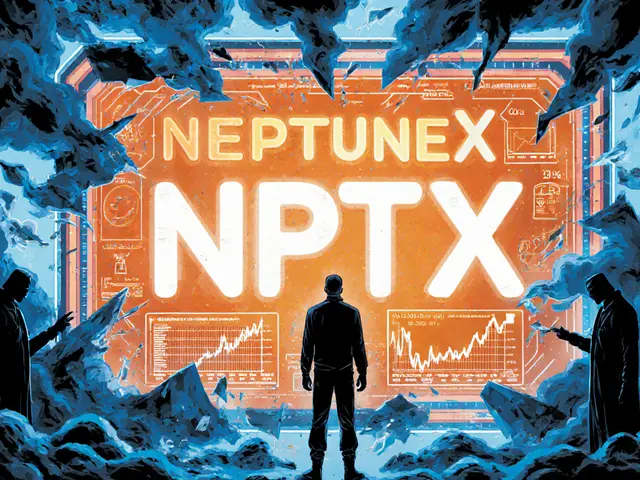Top Bitcoin Futures Trading Strategies for 2025
Bitcoin Futures Strategy Calculator
Results Summary
Long Position Strategy
Go long on Bitcoin futures when expecting price appreciation. Use stop-losses to manage risk.
Medium RiskShort Position Strategy
Go short on Bitcoin futures when expecting price decline. Requires careful monitoring.
High RiskHedging Strategy
Use futures to protect existing Bitcoin holdings from adverse price movements.
Low RiskArbitrage Strategy
Profit from funding rate differences between spot and futures markets.
Medium RiskWant to profit from Bitcoin’s wild price swings without actually holding the coin? Bitcoin futures trading lets you lock in a future price, go long or short, and use leverage-perfect for both speculative bursts and solid hedging.
What Bitcoin Futures Actually Are
Bitcoin futures are derivative contracts that obligate the buyer to purchase, or the seller to deliver, Bitcoin at a pre‑determined price on a future date. They first appeared on the Chicago Mercantile Exchange (CME) in December 2017, opening the door for regulated, institutional‑grade exposure to the crypto market.
1. Directional Strategies: Riding the Trend
For beginners, the simplest approach is to forecast whether Bitcoin’s price will rise or fall and take a matching long or short position. Because Bitcoin trades 24/7, you can enter a trade at any hour, but you also need to be ready for sudden sentiment shifts.
- Long bias: Buy a futures contract when you expect a price surge. Set a stop‑loss a few percent below your entry to protect against unexpected drops.
- Short bias: Sell a futures contract if you think the market will correct. Use a stop‑loss above your entry to limit upside risk.
Perpetual swap contracts-futures without an expiry-are especially popular. They let you stay in a position as long as you can meet the funding rate, which swaps hands every eight hours based on the spread between the contract and spot price.
2. Hedging Techniques: Protecting Real‑World Exposure
Traders who actually own Bitcoin or plan to buy it later use futures to lock in a price and neutralize volatility.
- Short hedge: If you hold physical Bitcoin, sell an equivalent amount of futures contracts. When the market dips, gains on the short futures offset losses on the spot holdings.
- Long hedge: If you plan to acquire Bitcoin in the next few months, buy futures now. A price rise will be captured by the long contract, reducing the cost of the future purchase.
Because Bitcoin can swing more than 50% in a month, a well‑timed hedge can save millions for institutional portfolios.
3. Fee‑Minimization and Exchange Selection
High‑frequency or leverage‑heavy traders feel fees the most. Choose an exchange with a tight maker‑taker spread, rebate programs, and token‑holder discounts.
| Exchange | Maker fee | Taker fee | VIP/rebate |
|---|---|---|---|
| Binance | 0.02% | 0.04% | Up to 0% for BNB‑staking users |
| Bybit | 0.025% | 0.075% | 0% for VIP tier5+ |
| BitMEX | 0.025% | 0.075% | 0% for high‑volume traders |
Using limit orders on these platforms avoids taker fees, and holding native tokens (BNB, BYT) can shave off another few basis points.
4. Technical Analysis & Automated Bots
Because Bitcoin never sleeps, many traders rely on indicators that work across timeframes.
- Bollinger Bands: Spot over‑extension when price hugs the upper band-potential short entry.
- RSI (Relative Strength Index): Values above 70 hint at overbought conditions; below 30 signal oversold.
Platforms like 3Commas and TradeSanta let you code bots that trigger entries based on those levels. A simple bot might: (1) pull real‑time price data, (2) calculate Bollinger Bands and RSI, (3) open a 5‑% leveraged long if price touches the lower band and RSI < 30, then set a trailing stop‑loss at 2%.

5. Leverage, Margin, and Capital Efficiency
Leverage amplifies both profit and loss. Platforms such as Bybit now offer up to 100:1 on Bitcoin perpetual contracts. Here’s a quick rule of thumb:
- Start with 5:1 or lower until you’re comfortable with liquidation thresholds.
- Never risk more than 1‑2% of your total capital on a single trade.
- Maintain a minimum of 10% free margin to survive funding‑rate spikes.
Funding‑rate arbitrage can add a modest 0.01‑0.03% per 8‑hour interval when the perpetual contract trades above the spot market. Capture it by simultaneously holding a spot position and an opposite‑sized futures contract.
6. Day Trading vs. Long‑Term Futures Positions
Day traders chase intra‑day volatility, often using 1‑minute to 15‑minute charts. They need fast execution, solid stop‑loss discipline, and a clear profit target (e.g., 0.5‑1% per trade).
Long‑term “HODL‑futures” players ignore short‑term noise, keeping a position for weeks or months to ride broader market trends. This approach reduces trading‑fee drag and emotional stress but requires a larger capital cushion to survive drawdowns.
7. Risk Management Essentials
Every profitable trader follows three pillars:
- Stop‑loss orders: Place them 1‑2% away from entry on high‑volatility days, tighten them to 0.5% when the market stabilizes.
- Position sizing: Compute the dollar amount you’re willing to lose (e.g., 1% of account) and divide by the distance to your stop‑loss.
- Portfolio diversification: Combine Bitcoin futures with Ethereum, commodities, or equity index futures to lower correlation risk.
Keeping a detailed trading journal-entry time, rationale, fees, outcome-helps you spot patterns and refine your strategy over months.
8. Sentiment & Regulatory Monitoring
Bitcoin reacts sharply to news. Track three signal sources:
- Regulatory updates: U.S. CFTC rulings, EU MiCA guidelines, or China’s crypto bans often trigger price spikes.
- Social media sentiment: Tools that aggregate Twitter and Reddit chatter can forecast short‑term moves before they materialize on the order book.
- Institutional flow: Large futures positions reported by the CME Commitment of Traders (COT) report hint at market direction.
When a major regulator announces a favorable policy, consider a short‑term long futures position; a crackdown? Flip to a short hedge.
Putting It All Together: A Sample Trade Plan
Below is a step‑by‑step template you can adapt to any market condition.
- Market scan: Check the 4‑hour chart for Bollinger Band squeeze and RSI < 30.
- Signal confirmation: Verify low‑volume pullback on the order book and positive sentiment on Twitter.
- Position sizing: Allocate 1.5% of capital; with a 2% stop‑loss, this translates to a $300 risk on a $20,000 account.
- Leverage choice: Use 10:1 to keep margin requirements reasonable.
- Order entry: Place a limit buy at the lower Bollinger Band, set a stop‑loss 2% below, and a take‑profit at 3% above.
- Post‑trade review: Log the trade, note why the signal worked or failed, and adjust future parameters.
Running this template daily, while rotating between long and short setups, can generate steady returns over time-provided you stay disciplined with risk limits.
Frequently Asked Questions
What is the difference between a Bitcoin futures contract and a perpetual swap?
A futures contract has a fixed expiry date (e.g., monthly), after which it settles to cash or physical Bitcoin. A perpetual swap rolls over continuously, using an 8‑hour funding rate to keep its price near the spot market.
How much leverage is safe for a beginner?
Start with 5:1 or lower. Higher leverage magnifies liquidation risk, especially during Bitcoin’s sudden 10‑plus percent moves.
Can I hedge my spot Bitcoin holdings with futures?
Yes. Sell an equivalent amount of futures contracts (short hedge). Gains on the futures offset losses on the spot position if Bitcoin falls.
Do fees really eat into profits for high‑frequency traders?
Absolutely. A 0.04% taker fee on a $10,000 trade costs $4. Over hundreds of trades a day, that adds up. Using maker orders, rebate programs, and low‑fee exchanges can reduce the drag dramatically.
What tools help automate Bitcoin futures strategies?
Bots on 3Commas, TradeSanta, or custom Python scripts via the Bybit API can execute predefined entry/exit rules 24/7.









If you're gonna swing leverage, double‑check that stop‑loss. Riding a 10x position without a safety net is a recipe for a margin call. Keep your risk under 2% of the account, or you'll be crying.
Hedging with futures can protect your spot exposure while you still participate in upside. Make sure the hedge ratio matches your underlying position, preferably around 0.8 to 1.0. This way you avoid over‑hedging and retain flexibility.
The market whispers in paradoxes, promising ascent while trembling beneath the surface. One might view a long futures contract as a hope‑filled sail, yet the wind can turn without warning.
Most people chase the hype, but the real edge lies in funding‑rate arbitrage when the premiums flip. If you ignore the funding schedule, you’re leaving free money on the table. The downside? It can evaporate in a flash when liquidity dries.
Wow!!! The fee structure on many exchanges is baffling; you think you’re paying 0.02% and then-boom-extra taker fees appear!!! Always read the fine print!
They don’t want you to know how funding rates are set, it’s all a game behind the curtain. Keep your eyes peeled and your positions tight.
When you first dip your toe into Bitcoin futures, the allure of leverage can feel like a superpower.
But with great power comes an even greater responsibility to understand the mechanics.
First, recognize that futures are settled daily, meaning your P&L compounds each day you stay in the trade.
Second, always calculate your breakeven point after accounting for funding fees, maker‑taker spreads, and overnight financing.
Third, a well‑placed stop‑loss is not just a safety net; it’s a mental discipline tool that prevents panic.
Fourth, consider scaling into a position rather than going all‑in on a single entry.
Fifth, diversify your strategies-combine a long directional bet with a hedging overlay to temper volatility.
Sixth, monitor the open interest and order book depth; spikes often precede sharp moves.
Seventh, be wary of over‑leveraging on low‑liquidity contracts; slippage can eat your margin in seconds.
Eighth, keep a journal of each trade, noting why you entered, your risk parameters, and the outcome.
Ninth, review your journal weekly to spot patterns in both success and failure.
Tenth, stay updated on macro news, especially regulatory hints that can swing sentiment overnight.
Eleventh, remember that no strategy guarantees profit; risk management is the true backbone.
Twelfth, when you feel the urge to chase a sudden price swing, take a breath and ask if it fits your plan.
Finally, enjoy the process-trading is a continual learning journey, not just a money‑making sprint.
While funding‑rate arbitrage sounds sweet, the reality is that you need deep capital to make it worthwhile, and many platforms cap the maximum exposure.
Leverage amplifies both gains and losses; treat it like a double‑edged sword.
Oh sure, because everyone’s just sitting around sipping coffee while their margin wipes out. Take a step back before you chase the next wave.
I’ve seen beginners get burnt, but a disciplined stop‑loss saved my account more than once. Keep learning, and stay humble.
Thats the thing 😂, you neeed to check the taker fee before you go 10x, otherwise u r in trouble.
If you think a 5% stop‑loss is safe, you’ve never been liquidated.
The market is a beast that devours the overconfident and whispers to the patient; ignore it and you become its next meal.
To calculate the breakeven on a leveraged future, first compute the notional exposure by multiplying the initial margin by the leverage factor. Next, add the estimated funding fee per 8‑hour interval over the intended holding period. Finally, divide the total cost by the initial investment to obtain the percentage required for break‑even. Remember to round up to account for slippage.
Yeah, because nothing says ‘fun’ like watching your account melt in real time 😒. Maybe stick to buying coffee instead.
Contemplating the nature of risk, one realizes that futures are a mirror reflecting our own hubris.
The act of leveraging is akin to shouting into a canyon, expecting the echo to be our triumph.
Yet the canyon often returns a hollow emptiness, reminding us of mortality.
Each position we open is a question posed to the market: ‘Will you reward my confidence or punish my greed?’
The answer, hidden in price action, unfolds with relentless indifference.
In that silence, we find the true lesson-control the narrative within, not the chaotic external.
Therefore, discipline becomes the philosopher’s stone that transmutates leverage into wisdom.
Embrace the uncertainty, but never surrender your sanity to it.
Take a moment after each trade to note what went right and what slipped. This habit builds a feedback loop that sharpens your edge over time. Consistency beats occasional brilliance.
Every setback is a setup for a comeback
i think the market teaches us humility; when we think we know it all, it shows us who we really are. it's a reminder that learning never stops.